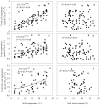Rates of litter decomposition and soil respiration in relation to soil temperature and water in different-aged Pinus massoniana forests in the Three Gorges Reservoir Area, China
- PMID: 25004164
- PMCID: PMC4087021
- DOI: 10.1371/journal.pone.0101890
Rates of litter decomposition and soil respiration in relation to soil temperature and water in different-aged Pinus massoniana forests in the Three Gorges Reservoir Area, China
Abstract
To better understand the soil carbon dynamics and cycling in terrestrial ecosystems in response to environmental changes, we studied soil respiration, litter decomposition, and their relations to soil temperature and soil water content for 18-months (Aug. 2010-Jan. 2012) in three different-aged Pinus massoniana forests in the Three Gorges Reservoir Area, China. Across the experimental period, the mean total soil respiration and litter respiration were 1.94 and 0.81, 2.00 and 0.60, 2.19 and 0.71 µmol CO2 m(-2) s(-1), and the litter dry mass remaining was 57.6%, 56.2% and 61.3% in the 20-, 30-, and 46-year-old forests, respectively. We found that the temporal variations of soil respiration and litter decomposition rates can be well explained by soil temperature at 5 cm depth. Both the total soil respiration and litter respiration were significantly positively correlated with the litter decomposition rates. The mean contribution of the litter respiration to the total soil respiration was 31.0%-45.9% for the three different-aged forests. The present study found that the total soil respiration was not significantly affected by forest age when P. masonniana stands exceed a certain age (e.g. >20 years old), but it increased significantly with increased soil temperature. Hence, forest management strategies need to protect the understory vegetation to limit soil warming, in order to reduce the CO2 emission under the currently rapid global warming. The contribution of litter decomposition to the total soil respiration varies across spatial and temporal scales. This indicates the need for separate consideration of soil and litter respiration when assessing the climate impacts on forest carbon cycling.
Conflict of interest statement
Figures






References
-
- Zimmermann M, Meir P, Bird M, Malhi Y, Ccahuana A (2009) Litter contribution to diurnal and annual soil respiration in a tropical montane cloud forest. Soil Biology and Biochemistry 41: 1–3.
-
- Raich JW (1998) Aboveground productivity and soil respiration in three Hawaiian rain forests. Forest Ecology and Management 107: 309–318.
-
- Raich JW, Schlesinger WH (1992) The global carbon dioxide flux in soil respiration and its relationship to vegetation and climate. Tellus 44B: 81–89.
-
- Prévost-bouré NC, Soudani K, Damesin C, Berveiller D, Lata JC, et al. (2010) Increase in aboveground fresh litter quantity over-stimulates soil respiration in a temperate deciduous forest. Applied Soil Ecology 46: 26–34.
Publication types
MeSH terms
Substances
LinkOut - more resources
Full Text Sources
Other Literature Sources

